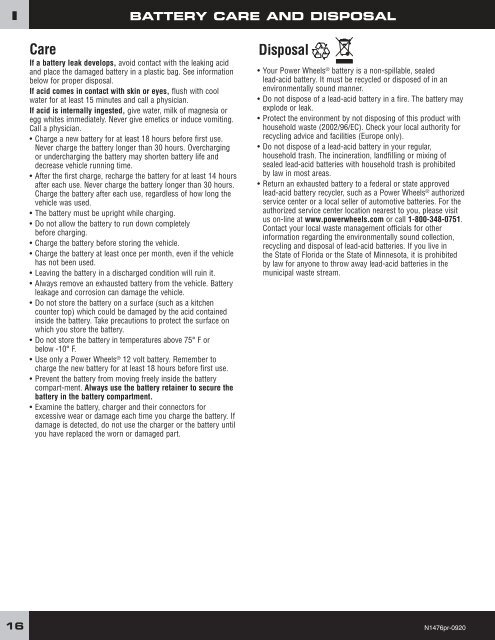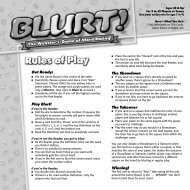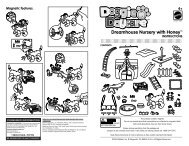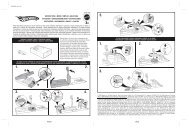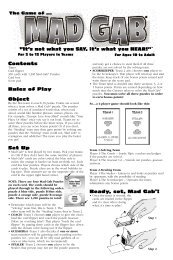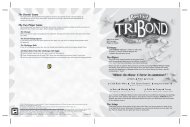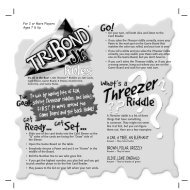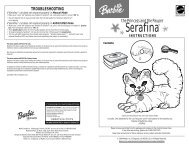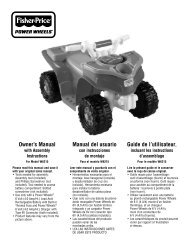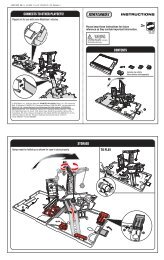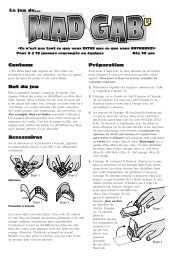Owner's Manual Owner's Manual
Owner's Manual Owner's Manual
Owner's Manual Owner's Manual
Create successful ePaper yourself
Turn your PDF publications into a flip-book with our unique Google optimized e-Paper software.
I<br />
BATTERY CARE AND DISPOSAL<br />
Care<br />
If a battery leak develops, avoid contact with the leaking acid<br />
and place the damaged battery in a plastic bag. See information<br />
below for proper disposal.<br />
If acid comes in contact with skin or eyes, flush with cool<br />
water for at least 15 minutes and call a physician.<br />
If acid is internally ingested, give water, milk of magnesia or<br />
egg whites immediately. Never give emetics or induce vomiting.<br />
Call a physician.<br />
• Charge a new battery for at least 18 hours before first use.<br />
Never charge the battery longer than 30 hours. Overcharging<br />
or undercharging the battery may shorten battery life and<br />
decrease vehicle running time.<br />
• After the first charge, recharge the battery for at least 14 hours<br />
after each use. Never charge the battery longer than 30 hours.<br />
Charge the battery after each use, regardless of how long the<br />
vehicle was used.<br />
• The battery must be upright while charging.<br />
• Do not allow the battery to run down completely<br />
before charging.<br />
• Charge the battery before storing the vehicle.<br />
• Charge the battery at least once per month, even if the vehicle<br />
has not been used.<br />
• Leaving the battery in a discharged condition will ruin it.<br />
• Always remove an exhausted battery from the vehicle. Battery<br />
leakage and corrosion can damage the vehicle.<br />
• Do not store the battery on a surface (such as a kitchen<br />
counter top) which could be damaged by the acid contained<br />
inside the battery. Take precautions to protect the surface on<br />
which you store the battery.<br />
• Do not store the battery in temperatures above 75° F or<br />
below -10° F.<br />
• Use only a Power Wheels ® 12 volt battery. Remember to<br />
charge the new battery for at least 18 hours before first use.<br />
• Prevent the battery from moving freely inside the battery<br />
compart-ment. Always use the battery retainer to secure the<br />
battery in the battery compartment.<br />
• Examine the battery, charger and their connectors for<br />
excessive wear or damage each time you charge the battery. If<br />
damage is detected, do not use the charger or the battery until<br />
you have replaced the worn or damaged part.<br />
Disposal<br />
• Your Power Wheels ® battery is a non-spillable, sealed<br />
lead-acid battery. It must be recycled or disposed of in an<br />
environmentally sound manner.<br />
• Do not dispose of a lead-acid battery in a fire. The battery may<br />
explode or leak.<br />
• Protect the environment by not disposing of this product with<br />
household waste (2002/96/EC). Check your local authority for<br />
recycling advice and facilities (Europe only).<br />
• Do not dispose of a lead-acid battery in your regular,<br />
household trash. The incineration, landfilling or mixing of<br />
sealed lead-acid batteries with household trash is prohibited<br />
by law in most areas.<br />
• Return an exhausted battery to a federal or state approved<br />
lead-acid battery recycler, such as a Power Wheels ® authorized<br />
service center or a local seller of automotive batteries. For the<br />
authorized service center location nearest to you, please visit<br />
us on-line at www.powerwheels.com or call 1-800-348-0751.<br />
Contact your local waste management officials for other<br />
information regarding the environmentally sound collection,<br />
recycling and disposal of lead-acid batteries. If you live in<br />
the State of Florida or the State of Minnesota, it is prohibited<br />
by law for anyone to throw away lead-acid batteries in the<br />
municipal waste stream.<br />
16 N1476pr-0920


